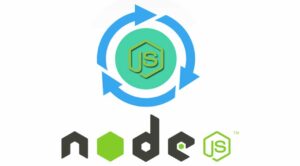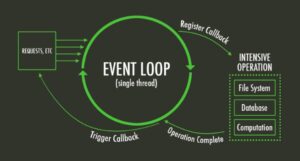Have you ever had a thought of asking someone about how exactly Nodejs event loop works?
If yes, please go through the whole blog to know how Nodejs carriers the event loop as a driven mechanism.

Nodejs is a single-threaded and the asynchronous behavior JavaScript language. In this platform, all those requests from the clients are handled in a single-thread using shared resources concurrently as it follows the “Event-Loop Model” architecture that runs on Google Chrome’s V8 engine.
This particular platform builds on top of the core JavaScript language in the programming environment and accessed through the browser APIs.
NODEJS EVENT LOOP

Event-loop programming is a flow control in an application-defined by events. The basic principle of Nodejs’s event-driven loop is implementing a central mechanism. It hears for events and calls the callback function once an event is turned up. Nodejs is an event-loop that implements a run-time environment model to achieve non-blocking asynchronous behavior.
An event-loop which is run by Node thread goes active until a task gets complete. Then it activates the secondary event which signals the event-listener function to execute the task on time.
As soon as Nodejs begins to work, it initializes an event loop that processes the given input script(i.e)variable initiation and function declaration which makes asynchronous API calls and schedule timers, then begins processing the event loop.
In the simple term, Event Loop in JavaScript is a constantly running process that checks if the call stack is empty. If the event queue has something that is waiting then it is moving to the call stacks and if not then nothing happens.
To understand the basic concepts of Nodejs event loop one should be aware of the following terms which used to execute a JavaScript code:
- Heap
- Stack
- Web API
- Callback queue
HEAP
Heap in the JavaScript is a place where objects are allocated for where objects stores. It mostly denotes the memory region with no proper structure.
STACK
In the event loop, stack represents the single-thread provided for JavaScript code execution. Technically, a Stack is a data structure that works in Last In First Out(LIFO) manners that holds all the JavaScript function call. Each function calls forms frame stacks.
Whenever in JavaScript, a function is called to push to the top of the stack. And then another function gets call simultaneously till the event ends. Then it continues to call concurrent function.
Web API
Web APIs are basically into a web browser and are capable to exhibit data from the browser and native computer environment. Such ability enables us to do some useful sophisticated things with it. Even if not being the part of the Javascript language, rather they build on top of the Javascript language provides a great power to use in JavaScript code execution.
CALLBACK QUEUE
In an execution process, If that particular function calls another function, then that function gets a call to the top of the stack. So the event loop process triggers a callback queue after the stack is empty. When our stacks have no function call then a process is pulling out from the callback queue and push it to stack back again.
Understand the Nodejs event loop with an example:
NO ASYNC CODE
We have seen some theoretical explanations about the event loop in Nodejs. Now let’s see how the event loop works in JavaScript:
console.log("first code"); console.log("second code"); console.log("third code");
In the above code, we are a simple console of three states such as first code, second code, and third code. They simply print the console in the same order as they are:
first code
second code
third code
Now let’s understand the above code in a step by step manner:
- When JavaScript engine runs the code then the initial state is empty for call stack, web API, callback queue.
- Now, JavaScript engine init, console.log(“first”) is added to the call stack.
- console.log(“first”) is executed.
- console.log(“first”) removed from the call stack.
- Now, console.log(“second”) is added to the call stack.
- console.log(“second”) is executed.
- After execution, console.log(“second”) removed from the call stack.
- Now the last line of the code, console.log(“third”) is added in the call stack.
- console.log(“third”) is executed.
- console.log(“third) is removed from the call stack.
This is how the event loop in Nodejs works and improves the performance of any Nodejs web applications.
Want to know more about the Nodejs event loop and its developmental process?. Contact us today to fix a free consultation.
Leave a Reply